15-Foot Invasive Pythons Are Moving North From Florida and Can’t Be Stopped
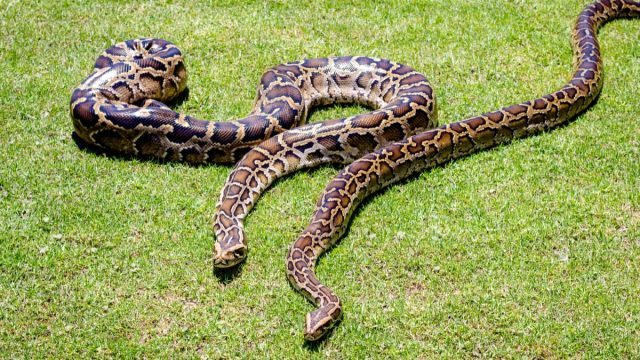
Even smaller, harmless snakes, like garter snakes and corn snakes, are enough to send shivers down some of our spines. But over the past year, venomous species like rattlesnakes and copperheads have also been reported in homes across the U.S., with numerous reports of sightings and bites. And now, a bigger kind of snake is on the move. Scientists have been monitoring invasive Burmese pythons in southern Florida for years, and they say the species is now moving north into new parts of the country. Read on to discover why this 15-foot species can’t be stopped.
RELATED: Giraffe-Sized Python Found in the U.S.—Why They’re Unstoppable.
Invasive pythons have been living in Florida since 2000.
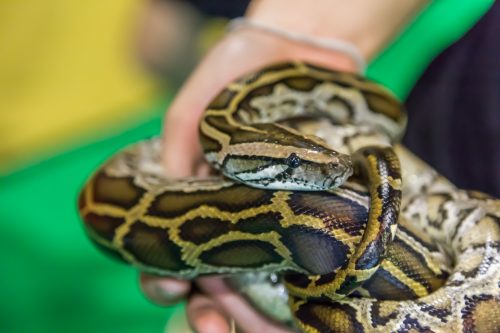
Back in February, scientists from the U.S. Geological Survey (USGS) released a report detailing the development of an invasive species of Burmese pythons making their home across the bottom half of Florida. According to the scientists, it was confirmed that these snakes had established a breeding population in the state’s Everglades National Park in 2000.
“The population has since expanded and now occupies much of southern Florida. They consume a wide range of animals and have altered the food web and ecosystems across the Greater Everglades,” the USGS noted, describing the invasive Burmese python as “one of the most challenging invasive species management issues worldwide.”
RELATED: 10 Rattlesnakes Removed From One Home—Here’s Where They Were Hiding.
Many of the snakes in this species are massive.
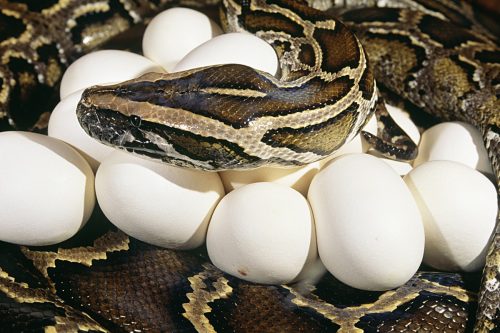
USGS researchers said that many of the invasive Burmese pythons found in Florida recently have weighed over 200 pounds and measured longer than 15 feet. A record-breaking 19-foot Burmese python was caught by local hunters in South Florida’s Big Cypress National Preserve in July of this year, NPR reported.
“Burmese pythons are large snakes, even as hatchlings,” the USGS scientists warned in their report, adding that some of these snakes can hatch at over two-feet long. “Large hatchling size may result in competitive and survival advantages over native snake species.”
Ian Bartoszek, a biologist with the Conservancy of Southwest Florida, recently told Insider that this size is what makes it easier for them to stay alive and reproduce.
“That’s their evolutionary secret weapon, they can get really big really quick,” Bartoszek said.
RELATED: 17-Year-Old Bitten by Rattlesnake in His Home—Where It Was Hiding.
Now they are moving north.
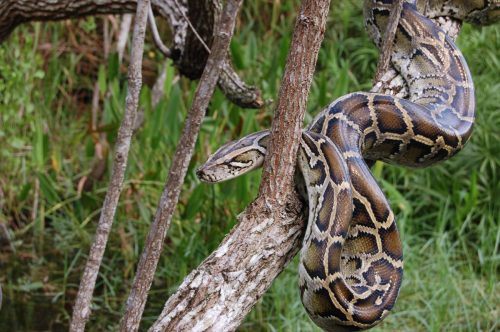
These snakes may not content themselves to staying put in Florida. Bartoszek told Insider that scientists are “seeing them show up in counties further and further to the north” every year.
According to the news outlet, it’s unclear just how far north the pythons live in Florida now. Current research indicates that they have spread at least as far as Lake Okeechobee, which is near West Palm Beach.
RELATED: Copperhead Encounters Spark New Warnings: “They Are Not Shy Snakes.”
Certain factors may make it easier for invasive pythons to spread even further.
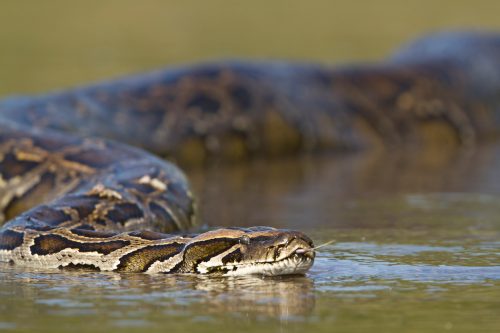
But models predict that the Burmese pythons could potentially move all the way up to the Pacific Northwest, into states like Oregon, Washington, and Idaho—and then into Canada, according to Insider. And while it would take decades for them to spread that far, certain factors may make it easier for them to do so.
For one thing, canals and deep-water levees might help these snakes get farther north, according to Melissa Miller, PhD, a scientist who specializes in invasive species research.
“There’s potential that they could help the pythons disperse,” Miller told Insider. “It could act as a bit of a python highway, but we don’t know that right now.”
Temperatures across the U.S. are also continuing to get warmer from climate change, which could help the pythons continue their migration. And they may also be able to survive colder temperatures up north: Florida’s population of pythons eventually bounced back after a cold spell in 2010, and the snakes that lived through it might be better adapted to lower temperatures, according to Miller.
“Those individuals, when they reproduce with other individuals that survived potentially could propagate a more cold-tolerant gene,” she explained to Insider.
RELATED: 8 Things in Your Yard That Are Attracting Snakes to Your Home.
Scientists are warning people not to “underestimate the Burmese python.”
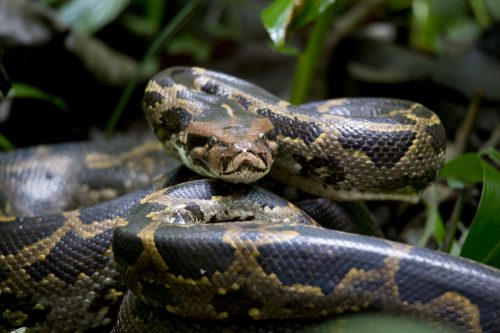
This species was first introduced into the U.S. “through the pet trade,” with over 300,000 snakes being imported from Thailand, Myanmar, and Vietnam, Miller told Insider. Burmese pythons then ended up making their way into the wild by either escaping or being let loose by their owners when they became too big to handle.
But it wasn’t until the early 2000s when scientists realized these snakes were breeding in the wild in southern Florida, and by then, it was too late, Insider reported. Their ability to adapt, survive, and reproduce has made them basically impossible to eradicate at this point, according to USGS scientists.
“It really does feel like an alien invasion,” Bartoszek told Insider, adding that just 10 years ago he would have said that Burmese pythons were just a Florida problem. “Then I just developed this mantra over the years of don’t underestimate the Burmese python.”
RELATED: For more up-to-date information, sign up for our daily newsletter.